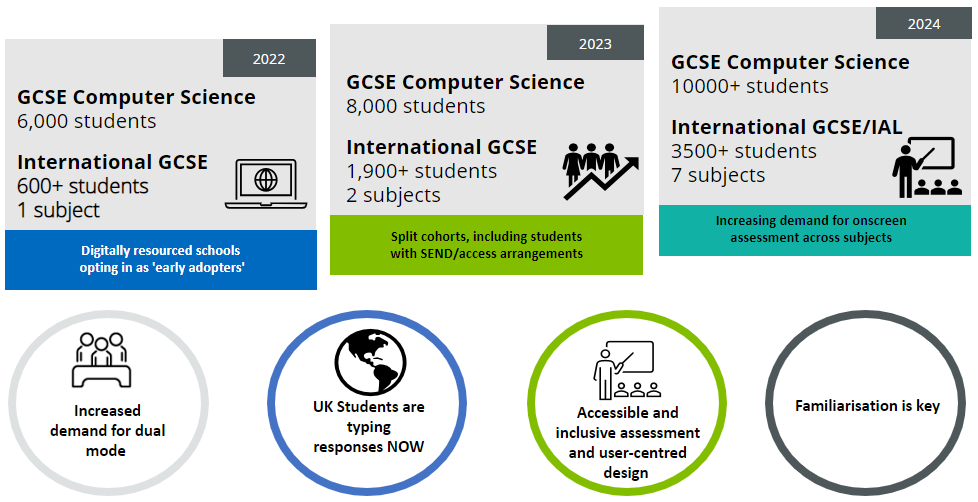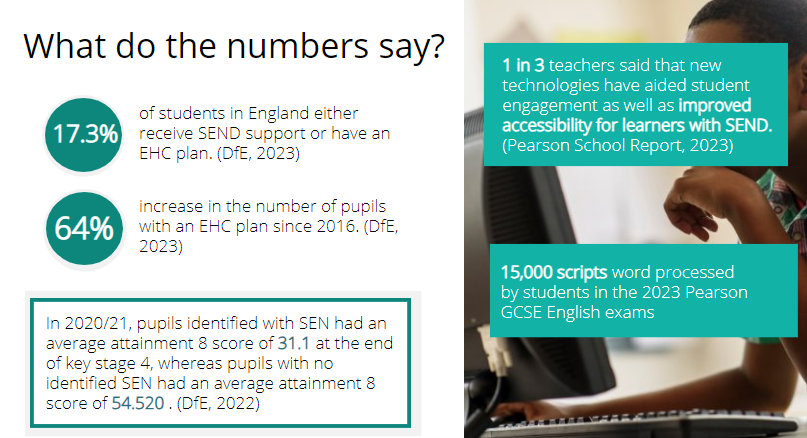
Pearson’s report into the future of qualifications and assessment, Building a 14-19 education system of choice, diversity and opportunity, highlighted a number of recommendations, including the need to ‘assess the right skills in the right way, enabling learners to highlight their strengths and successes’.
So, with this in mind, what should education reform for a new generation look like?
Meredith Reeve, Head of Next Generation Assessment at Pearson, shares our best current thinking and provides an overview of the progress we are making at Pearson to innovate learning and assessment to give choice to students.
The transition to onscreen assessment
In this article, I will share some of the key findings from Pearson’s latest research into education and assessment and highlight how we’re using that research as our ‘North Star’ as we move towards onscreen assessment as an option for our international and UK qualifications.
I’ll also share some of the work our digital assessment design team are conducting to consider student preferences and experiences in assessment and design more equitable solutions for all learners.
Digital innovation: the British curriculum policy context
There is significant interest at a policy level in the future of qualifications and the transition to onscreen assessment. A Department for Education in England (DfE) survey in 2020 and 2021 suggests that there are significant considerations, in terms of the cost, teacher motivation and other barriers to the use of edtech and moving towards onscreen assessment, that some schools are much further forward than others, but also that real opportunity exists in this space.
Ofqual, the UK, the regulator has indicated it will ‘support the use of innovative practice and technology and remove regulatory barriers where innovation promotes valid and efficient assessment’.
On balance therefore, there is real interest in onscreen assessment, but also concern about the potential impact for disadvantaged groups in the education community.
Pearson view: the future of qualifications and assessment
At Pearson, we have been carrying out a broad range of research in this area over the past few years. The Pearson Qualifications and Assessment report, launched in 2022, made several recommendations about the future of British curriculum assessment and qualifications.
“Assess the right skills in the right way, enabling learners to highlight their strengths and successes.”
Recommendation 5
Building a 14 -19 education system of choice, diversity and opportunity, Pearson’s report into the Future of Qualifications & Assessment 2022
One of the key recommendations is around assessing the right skills in the right way, allowing learners to highlight their strengths and successes. This is central to our approach in terms of innovation for all assessments, particularly onscreen.
And in terms of our progress, we continue to see significant growth in the uptake of onscreen assessment for our Pearson Edexcel qualifications.
Following a successful onscreen assessment pilot for our International GCSE English language qualification in 2022, we launched onscreen assessment globally for that qualification along with International GCSE English Literature. In 2023, we saw more than 1,900 students take these assessments onscreen in the May/June exam series, with schools adopting different strategies depending on their cohorts.
Some international schools entered their full cohort for the onscreen exams. Others split their cohort depending on student preference and need, for example where students had SEND/access arrangements in place and for whom word processing, or the use of interactive PDFs, was their normal way of working.
We are also seeing steady growth in the number of students taking Pearson Edexcel GCSE Computer Science, a fantastic qualification that enables real life coding in the assessment; 6,000 students sat this qualification onscreen in 2023, and this number will rise to over 10,000 students sitting GCSE Computer Science onscreen in 2024.
Also this year, we are adding three new International GCSE and two new International A level subjects to our onscreen portfolio, with more than 3,500 assessments to be sat by students in over 30 schools across the globe. This means that for the first time, we are able to offer progression for students who completed their assessments onscreen at GCSE level, to then do the same at International A level.
The future looks bright for onscreen assessment, but familiarisation is key. Our onscreen mock services provide students, teachers, exam officers and in-school support staff with the confidence they need prior to their students taking external high stakes assessments onscreen, and through this process, we can demonstrate the robustness of our onscreen delivery model to every stakeholder involved in the process.
Student choice: assessment that reflects students’ learning approaches
Designing assessments that allow students to sit qualifications in the same way they learn is a key driver for us.
To illustrate this, in 2019 we received fewer than 10,000 learner-typed scripts across our entire qualifications portfolio. Fast-forward to 2023, we received 15,000 typed GCSE English scripts alone, from students for whom using word processor is their normal way of working. We’re seeing a significant increase in the proportion of students for whom using computers or technology in their assessments is a normal way of working.
For us, being able to providing that choice both in the UK as well as internationally is a key next step in our onscreen assessment roadmap.
Driving more accessible, inclusive assessments
With the increasing use of digital technology for learning and assessment, we are keen to understand how technology can enhance students’ exam experiences and provide equitable digital assessment experiences for all learners. So, alongside our work in onscreen assessment, our digital assessment design team at Pearson has been carrying out research with a range of learners to inform more accessible, more inclusive assessments in the future.
We have broad and ambitious commitments around DE+I. We want to create learning experiences that build a more just and inclusive world, and drive the transformation of learning, making it more diverse, equitable and inclusive. We are doing this partly by creating more opportunities for diverse perspectives to be heard and valued, and by focusing on digital accessibility and the accessibility of our exam content.
Following the publication of Ofqual’s statutory guidance on designing and developing accessible assessments in 2022 (Ofqual, 2022), there is also an increased regulatory impetus involved in the design and development of accessible assessments, making this a hot topic within the educational assessment community.
Statistics reveal that almost one in five or 17.3% of learners in England receive support for Special Educational Needs and/or Disabilities (SEND) or have an Education, Health and Care Plan in place. This is a continuing upward trend from 2016 and does not include those who are undiagnosed or unaware that they have particular needs. When combined with data that shows SEND learners receive lower average attainment 8 scores compared to students with no identified SEND, it paints a compelling picture about the need to understand the provision and support in place for students with SEND.
So, across our digital assessment design and assessment research teams, we have been undertaking a programme of research and design activities that focus on the experience of SEND learners when taking high-stakes exams across different formats, orientated towards designing more inclusive assessments for all our learners.
This programme of research and design comprises exploring existing literature to understand what we can learn and apply from the research that already exists, as well as developing case studies to showcase the lived experience of students in schools and colleges. We’re exploring how modified exam formats are accessed and used by students in their educational settings.
Our research provides a means of better understanding the SEND learner experience, a group often underrepresented in existing research. We utilise learner-centred design approaches to ensure that our digital assessments are as accessible, fair, valid and fit-for-purpose as possible and here, student and teacher feedback is key.
This evidence, along with industry standards and best practice, is then used to inform a programme of evidence-based accessibility improvements, including improvements in our modified exam formats. And here, for example, we’re working to ensure images are as accessible as possible, focusing on the optimisation of text styling and formatting and exploring in-built Text to Speech functionality.
Improving the accessibility of digital assessments is a journey and our research continues to pave the way for further exploration into how we can further improve the test-taker experience for learners in future.
Key themes from our research
As we build our approach to onscreen high-stakes assessment and more inclusive digital assessments, some key themes are emerging from our research.
Equity benefits
Offering onscreen modes of delivery presents us with exciting opportunities to embed accessibility, personalisation and inclusive design principles into our assessments. This can benefit the entire tested population, however, it will have particular benefits for students with SEND. More accessible examinations can provide SEND students with better opportunities to demonstrate their abilities. This can help enhance equitable access where schools and students currently face challenges caused by inaccurately diagnosed and undiagnosed SEND conditions, resource constraints and stigma.
Customisation and personalisation
In our studies with learners, customisation and personalisation options within assessments are really important to learners with SEND, allowing them a sense of agency in using these features to meet their individual needs, rather than reliance on human helpers, where this is appropriate to do so.
Student voice
We strongly believe that student voice is critical to the transition to digital high-stakes assessment. Every student’s learning and assessment experience is unique. This is even more pertinent when we acknowledge the diversity that exists within and across different SEND conditions and consider learners’ individual needs and preferred methods of support.
That’s why our research places the learner at the heart. Enhancing our understanding of students’ lived experiences is a vital part of the process of improving the accessibility of digital assessments.
In conclusion
The transition to high stakes digital assessment provides opportunities to significantly improve student experience and test accessibility. Through our research, we’re hearing from learners and schools about how digital technology can, and already is, supporting increased student agency, greater independence and confidence.
Ultimately, we should acknowledge that there is not a one-size-fits-all approach and that this is a journey. Some adaptation and modifications are likely always to be required to meet the individual needs of learners to give them the best chance of demonstrating what they know and what they can do.
We’re using our collective research to drive a programme of improvements across formats, be that onscreen, paper-based and modified exam formats and are already supporting learners with diverse accessibility needs in onscreen exams.
And encouragingly, there is more to come.
Further reading
Learn more about onscreen assessment.
Subscribe to our blog
If you’d like to stay up to date with our latest articles, why not subscribe to our blog? You’ll get a fortnightly roundup of the articles you’ve missed straight to your inbox, plus links to free teaching resources.



